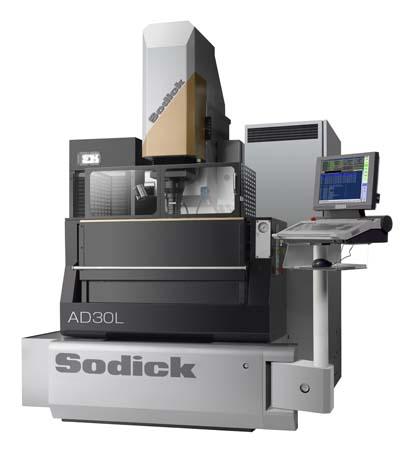
Sodick Inc. is releasing the AD30L linear motor driven Sinker EDM. The AD30L Sinker EDM features a small footprint and linear motor drives on 3-Axes.
The AD30L features the SVC Circuit. Voltage is controlled by the SVC Circuit; therefore the surface finish can be uniformly and efficiently controlled to provide a high-grade texture or mirror surfaces in a very short period of time.
The AD30L also achieves Zero Electrode Wear. This Zero Electrode Wear technology allows the EDMing of steel materials with virtually zero electrode wear when using graphite or copper electrodes. Less electrode wear results in fewer electrodes required for machining, saving on production costs and errors associated with multi-electrode preparation. The AD30L has an X, Y, Z travel of 12.59" (320mm) x 7.87" (200mm) x 9.84" (250mm) and can accommodate workpieces up to 1,212 lbs (550 kg).
The AD30L can reduce EDMing time by up to 50 percent over conventional EDMs. Since the AD30L is linear motor driven, there are no ball screws or couplings and backlash is completely eliminated. Glass scales are on the X, Y and X axes ensuring complete accuracy. The AD30Lcomes standard with a 10-year positioning guarantee to provide the user with peace of mind knowing that positioning accuracy will not be lost.
Contact Details
Related Glossary Terms
- backlash
backlash
Reaction in dynamic motion systems where potential energy that was created while the object was in motion is released when the object stops. Release of this potential energy or inertia causes the device to quickly snap backward relative to the last direction of motion. Backlash can cause a system’s final resting position to be different from what was intended and from where the control system intended to stop the device.
- electrical-discharge machining ( EDM)
electrical-discharge machining ( EDM)
Process that vaporizes conductive materials by controlled application of pulsed electrical current that flows between a workpiece and electrode (tool) in a dielectric fluid. Permits machining shapes to tight accuracies without the internal stresses conventional machining often generates. Useful in diemaking.
- linear motor
linear motor
Functionally the same as a rotary motor in a machine tool, a linear motor can be thought of as a standard permanent-magnet, rotary-style motor slit axially to the center and then peeled back and laid flat. The major advantage of using a linear motor to drive the axis motion is that it eliminates the inefficiency and mechanical variance caused by the ballscrew assembly system used in most CNC machines.
